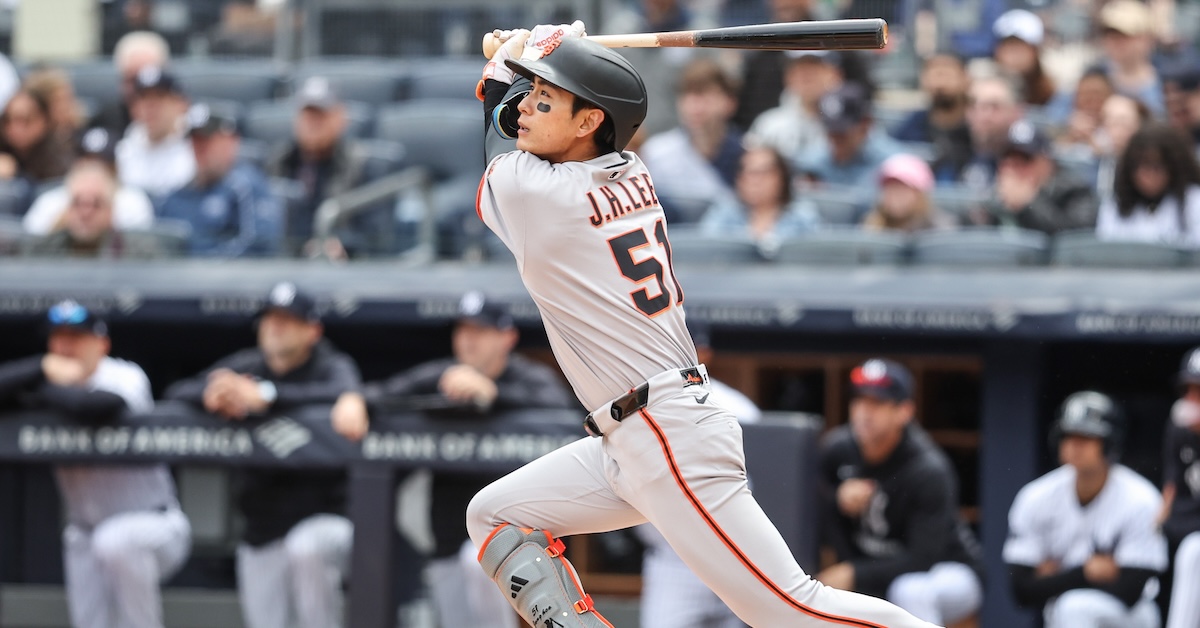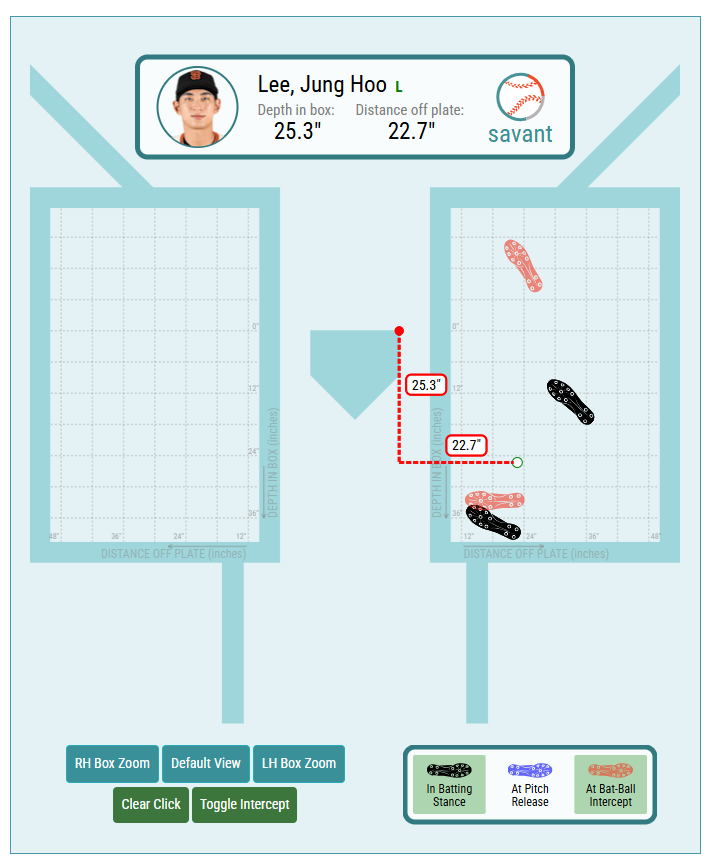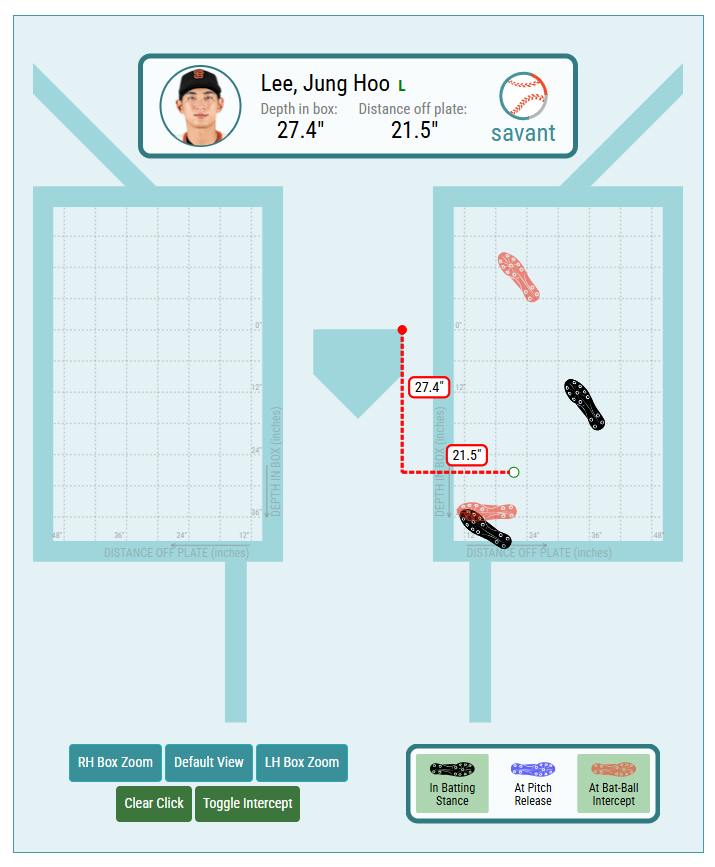No player wants to suffer a significant, season-ending injury like Jung Hoo Lee did last May, especially in their rookie year. But when players do find themselves in that situation, they can at least use the time to reflect on their performance and make adjustments that they think will improve their game upon their return. Despite it being early in the season, it seems that is exactly what Lee has done.
The Giants center fielder’s offensive improvements warrant a look under the hood to see exactly what he has changed, because right now, he seems like a completely different player from the one we saw last year. So far this season, Lee is sporting a 192 wRC+, a .394 xwOBA (86th percentile), a 43.1% sweet-spot rate (87th percentile), and a .446 xwOBACON. Those are all big improvements compared to his limited 2024 sample.
In churning through Lee’s video this season, one thing stuck out to me above all else: his ability to get his torso and arms fully extended while maintaining a great bat path. This has allowed him to cover the outer third of the plate at a high level. I have a particular affinity for hitters who reach across the zone with their arms and still make flush contact. It can be difficult to keep your bat on a positive slope while reaching that far out in front – hitters tend to roll these pitches over because their path begins to work in a horizontal direction instead of a vertical one. But if you have the upper body mobility and strength to maintain a direct, upward path to the ball before rotating open, then you’re going to be a nightmare to pitch to. Here’s a quick summary of how Lee’s outer third performance compares to last season:
Jung Hoo Lee Outer Third Performance
| Season | xwOBA | Swing% | Swing Length | Whiff% |
|---|---|---|---|---|
| 2024 | .271 | 50.0% | 7.3 | 8.2% |
| 2025 | .450 | 57.4% | 7.5 | 5.7% |
SOURCE: Baseball Savant
It’s always gratifying when your initial read on a hitter’s swing style matches the data, even in a limited sample. The takeaway is that so far, Lee has been a bit more aggressive on the outer third, is performing significantly better, and has slightly lengthened his swing. That surprised me, though, because during spring training, Lee spoke about how some of the swing changes he made would lead to a deeper point of contact. When doing player analysis, I try to seek out any conversations the player has had about their swing mechanics. With Lee, that source just happened to come from a Reddit thread where a user translated the interviews Lee did in spring training (there are YouTube videos linked in the post).
To summarize, Lee’s focus heading into the season was to shift his point of contact back. Last year, he tried to make contact farther out in front than in he did in the KBO to adjust for the higher velocities in MLB, but he said that change led to pushy swings and a lot of groundballs. This year, he’s shifted his mentality to a deeper point of contact, which has played out with the data thus far. His intercept point in 2024 was 32.7 inches relative to his center of mass. This season, it’s 31.1 inches. And while he’s making deeper contact relative to his center of mass, he’s also shifted back in the box. Overall, he’s given himself more space (and time) to create line drive lift on pitches, which has helped a ton on the outer third.
Before turning to some video, let’s look at Baseball Savant’s new tool, which highlights a hitter’s initial stance (position of the feet) and how that changes at contact, as well as their average point of contact relative to their body and home plate. The first image is last season and the second image is this season:
This is fascinating to me. Lee’s stance angle has opened up from 33 degrees to 40, and he’s landing with his plant foot ever so slightly more closed despite his stance still being open. This is a crucial difference. With his front foot in a different position, he changed the direction of his rotation. As a left-handed hitter, landing too open can shift your rotational direction toward right field, which can lead to many groundballs. Closing off his foot aligns his direction toward the center of the field and therefore puts him in a better position not only to protect the outer third, but also to do damage there.
But how does Lee manage to keep his stance open at landing? Yes, he’s closed it relative to last year, but it’s still open. Well, that brings us back to his upper body mobility, the physical trait that carries his profile and allows him to land open and still have ideal rotational direction. Let’s look at some video from this season to see that mobility in action:
At the end of each swing, Lee’s upper body is guiding the angle of his barrel either on a flat path (like on the line drive against Will Warren in the first GIF) or on an upward path with lots of torso extension (like against Steven Okert in the second GIF). When a hitter is able to bend their torso backwards to the extent Lee can, it allows them to create a bat path that starts deep in the hitting zone (think a positive attack angle closer to the catcher), which in turn not only lets them lift pitches at the top of the zone with authority, but also elevate pitches at deeper contact points.
Lee’s swing against Hunter Greene, seen in the final GIF, is most indicative of the depth he creates in his bat path. The fact that he was even able to muster hard contact on this pitch is ridiculous. This season, only four left-handed hitters have base hits on pitches at least 99 mph on the outer third against right-handed pitchers. Lee’s hit against Greene is one of the four, and it is one of only two such hits that also had an exit velocity above 95 mph, with the other coming from Freddie Freeman.
Basically, it isn’t normal for a hitter to execute such a fantastic swing against 99 mph heat on the corner. You need to balance upper body mobility and extension with having a firm base that keeps your lower body stable throughout your rotation. The latter speaks to the final point of how a few slight adjustments to Lee’s stance aided these swings. On top of adjusting his stance angle and the position of his front foot, he has widened out by 3.2 inches. Each of these pieces works together to give Lee a stronger base to work from, which helps him stay on plane longer by not rotating too early in his swing and pulling off these pitches.
It is very, very early. But based on the logic of Lee’s adjustments, I feel pretty confident that he is a better hitter now. Pitchers will inevitably adjust to him, taking their turn in the cat and mouse game of batter versus pitcher, but if his early performance is any indication, he has markedly improved his plate coverage. That alone should help him be more adjustable as pitchers tinker with their approach.
Content Source: blogs.fangraphs.com



